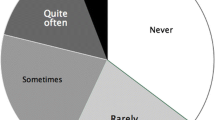Abstract
The objective of this investigation is to use the health belief model (HBM) to explain the percentage of calories from fat in the diet (PCF) for marital partners. The model includes four sets of determinate variables: perceived threat of a high-fat diet, barriers to a healthier diet, food choices made for health reasons, and self-efficacy, as well as sociodemographic background factors. One hundred fifty-five married couples were selected by a random area sample from the state of Iowa. Husbands and wives were interviewed separately in the home. The results partially support the HBM as applied to a nutrition domain and revealed interesting gender differences. For wives the cost of healthy diet changes had an effect on PCF. For husbands, perceived threat and self-efficacy had an effect on PCF. The differences are discussed on the basis of gender roles in the home and gender socialization.
Similar content being viewed by others
References
Bandura, A. (1977). Self-efficacy: Toward a unifying theory of behavioral change.Psychol. Rev. 84:1191–215.
Bandura, A. (1986).Social Foundations of Thought and Action, Prentice-Hall, Englewood Cliffs, NJ.
Becker, H. M., Maiman, L. A., Kirscht, J. P., Haefner, D. P., and Drachman, R. H. (1977). The Health Belief Model and prediction of dietary compliance: A field experiment.J. Health Soc. Behav. 18:348–366.
Block, G., Hartman, A. M., Dreser, C. M., Carroll, M. D., Gannon, J., and Gardner, L. (1986). A data-based approach to diet questionnaire design and testing.Am. J. Epidemol. 124: 453–469.
Economic Research Service (1988). Food consumption.Natl. Food Rev. 11(2):1–11.
Gecas, V. (1989). The social psychology of self-efficacy.Ann. Rev. Sociol. 15: 291–316.
Gunnar-Von Gnechten, M. R. (1978). Changing a frightening toy into a pleasant toy by allowing the infant to control its actions.Dev. Psychol. 14: 157–162.
Hochbaum, G. M. (1958). Public participation in medical screening programs: A sociopsychological study.Public Health Service Publication 572.
Hollis, J. F., Carmody, T. P., Connor, S. L., Fey, S. G., and Matarazzo, J. D. (1986). The Nutrition attitude survey: Associations with dietary habits, psychological and physical well-being.Health Psychol. 4: 359–374.
Human Nutrition Information Service (1985). Continuing survey of food intakes by individuals, women 19–50 years and their children 1–5 years, 1 day, 1985. Nationwide Food Consumption Survey, U.S. Department of Agriculture, Report No. 85-1.
Human Nutrition Information Service (1986). Continuing survey of food intakes by individuals, men 19–50 years, 1 day, 1985. Nationwide Food Consumption Survey, U.S. Department of Agriculture, Report No. 85-3.
Janz, N. K., and Becker, M. H. (1984). The Health Belief Model: A decade later.Health Educ. Q. 11: 1–47.
Joreskog, K., and Sorbon, D. (1989).Lisrel User's Guide, Scientific Software, Mooresville, IN.
Larson, E. B., Olsen, E., Cole, W., and Shortell. (1979). The relationship of health beliefs and a postcard reminder to influenza vaccination.J. Family Prac. 8: 1207–1211.
Loudon, D. L., and Della Bitta, A. J. (1993).Consumer Behavior. Concepts and Applications, 4th ed., McGraw-Hill, New York.
Mullen, P. D., Hersey, J. C., and Iverson, D. C. (1987). Health behavior models compared.Soc. Sci. Med. 24: 973–981.
National Cancer Institute (1989). Health Habits and History Questionnaire: Diet History and Other Risk Factors—Personal Computer System Packet, Division of Cancer Prevention and Control, National Institutes of Health, Bethesda, MD.
Rosenstock, I. M. (1974). Historical origins of the Health Belief Model.Health Educ. Monogr. 2: 328–335.
Rosenstock, I. M. (1990). The Health Belief Model: Explaining health behaviors through expectancies. In Glanz, K., Leins, F. M., and Remer, B. K. (eds.),Health Behavior and Health Education: Theory, Research and Practice, Jossey Bass, San Francisco.
Rosenstock, I. M., Strecher, V. J., and Becker, M. H. (1988). Social learning theory and the health belief model.Health Educ. Q. 15: 175–183.
Schafer, R. B., and Schafer, E. (1989). Relationship between gender and food roles in the family.J. Nutr. Educ. 21: 119–126.
Schafer, R. B., Schafer, E., Bultena, G. L., and Hoiberg, E. O. (1993). Food safety: An application of the health belief model.J. Nutr. Educ. 25: 17–24.
Shattuck, A. L., White, E., and Kristal, A. R. (1992). How women's adopted low-fat diets affect their husbands.Am. J. Public Health 82: 1244–1250.
Strecher, V. J., DeVellis, B. M., Becker, M. H., and Rosenstock, I. M. (1986). The role of self-efficacy in achieving health behavior change.Health Educ. Q. 13: 73–92.
Thompson, L., and Walker, A. (1989). Gender in families: Women and men in marriage, work and parenthood.J. Marriage Family 50: 749–761.
U.S. Department of Health and Human Services (1990).Healthy People 2000, National Health Promotion and Disease Prevention Objectives, USDHHS, Washington, DC.
Author information
Authors and Affiliations
Rights and permissions
About this article
Cite this article
Schafer, R.B., Keith, P.M. & Schafer, E. Predicting fat in diets of marital partners using the health belief model. J Behav Med 18, 419–433 (1995). https://doi.org/10.1007/BF01904772
Accepted:
Issue Date:
DOI: https://doi.org/10.1007/BF01904772




